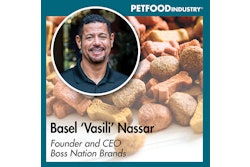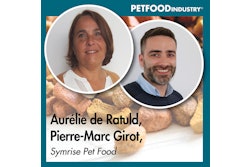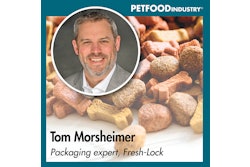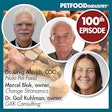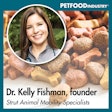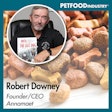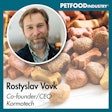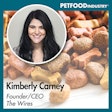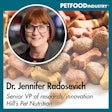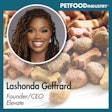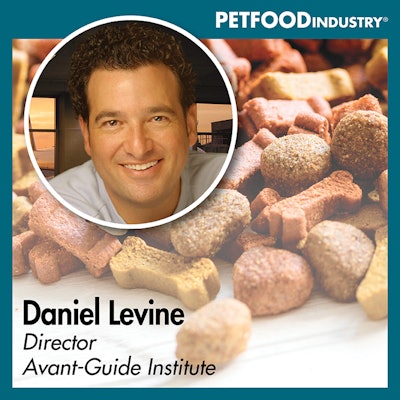
I spoke with Daniel Levine, director of The Avant-Guide Institute, about the various connections between what’s happening in the human food space and the trends driving the pet food space. We covered a lot of ground, so if you've ever wondered about parallel trends and how they happen among different industries, tune in!
The below transcript is from Episode 57 of the Trending: Pet Food podcast, where I spoke with Daniel Levine, director of The Avant-Guide Institute, about the various connections between what’s happening in the human food space and the trends driving the pet food space. You can find the episode at www.PetfoodIndustry.com/trending-pet-food-podcast, on SoundCloud or on your favorite podcast platform. This episode originally aired on March 13, 2024.
(We want to thank AFB International for sponsoring this podcast. AFB is the premier supplier of palatants to pet food companies worldwide, offering off-the-shelf and custom solutions and services that make pet food, treats and supplements taste great.)
Lindsay Beaton – Editor, Petfood Industry magazine and Host, Trending: Pet Food podcast
Hello, and welcome to Trending: Pet Food, the industry podcast where we cover all the latest hot topics and trends in pet food. I’m your host and editor of Petfood Industry magazine Lindsay Beaton, and I’m here today with Daniel Levine, director of The Avant-Guide Institute. Hi Daniel, and welcome!
Daniel Levine – Director, The Avant-Guide Institute
Hey, Lindsay, how are you doing?
Beaton: In case you’ve not yet been introduced to Daniel or The Avant-Guide Institute, here’s what you need to know.
Daniel operates The Avant-Guide Institute, a New York-based trends consultancy, and works with many companies, including McDonald’s, American Express, Microsoft and Dior, to help them anticipate the coming trends that could most affect their businesses. He leads a large team of trendspotters who track the latest ideas and experiences around the globe. Daniel is also the author of more than 20 best-selling books and is a regular TV and radio guest, and public speaker.
The Avant-Guide Institute is a leading authority on business trends, consumer trends and technology trends driving the global marketplace. The consultancy helps companies from almost every industry understand major trends that are motivating customers to buy products, services and experiences, then develops powerful responses to those trends in order to help clients be more relevant, innovative and profitable.
Daniel Levine is our opening keynote speaker for Petfood Forum 2024, being held at the end of April and beginning of May, and he’ll be speaking on “Barking up the right tree: How consumers, culture and technology are changing the way people feed their pets.” This, alongside his extensive experience and access to all things trending, is why I’ve brought him on today to answer this question: What are some of the connections between human food consumer trends and pet food consumer trends?
Daniel, I want to start our conversation by talking a little bit more about The Avant-Guide Institute, because I would love to know how you guys look ahead to figure out consumer trends in general, and if you have any specific specialties or favorites that you'd like to look into in terms of trends.
Levine: Well, one of the things that sets us apart is we have a huge team of trendspotters around the world, and these are people who every day are finding things that are new and unique and unusual in some way. And when we start to see in our New York office the same kinds of thing happening in the same psychographic or demographic or geographic, we connect those dots to see trends that are forming. And as you can imagine, that's a pretty powerful thing for companies to know about, to see trends as they happen, because trends are sort of like the secret sauce that let you get inside your customers’ heads to see what they're thinking and feeling even before they themselves know it.
We have a really broad umbrella, and the reason for that is because when it comes to a lot of these trends, I'd even say most trends, they're not siloed by industry. Trends are about what's happening in the world and again, what people are thinking and feeling; it's about what's in the ether. And I believe that companies can learn so much from looking outside of their own industry to see what's working. Trends offer that. Most businesspeople, they know an awful lot about what's happening in their own industry, but they don't know a whole lot about what else is going on, and of course that's really key and helpful because you can see what's working in other industries and then co-opt that and use that yourself.
One of the things that we're going to speak about today in this podcast is what the pet food industry can learn from the human food industry. And that's obviously not a new issue with pet food; pet food has often looked at the human food industry. But I think even the human food industry is not the leading indicator for pet foods. The leading indicator is from many different industries around the world that your customers are reacting to, again because the trends they're looking for are not siloed by industry. It's not like they're looking for one trend when it comes to the food they feed their pets; it's completely different thinking when it comes to what they're feeding themselves or the cars they're driving or the clothes they're wearing. It's about lifestyle.
Beaton: I love that, because it takes the analysis of trends and both zooms really far in, but then zooms out to — it's almost like a holistic way of looking at trends and understanding that everything around a consumer, everything around us, affects our behavior and how we're going to react to a product or what we're looking for or what we need in our lives. So I'm really excited to have this conversation, because I'm always interested in what everybody is up to in terms of trends, and I always like to know more about what maybe even I as a consumer am doing that I might not realize.
Levine: Ah, we’re going to get inside your head.
Beaton: Yes, that's one of the big things I like about learning about trends is I also get to analyze myself in the process.
Levine: It is about consumer behavior and consumer psychology. And it's very broad, it’s about all of us. It's about you, and me and everybody.
Beaton: What are consumers up to right now? No silos, not necessarily food, what are we all doing right now?
Levine: Okay, there's some very big trends, and none of these are going to shock your listeners: Robots taking our jobs, or at least changing our jobs. We will all be working with robots or AI in some way if we're not already, and it will be even more intense next year than it is this year. You know, examples being McDonald's self-serve kiosks; being robots, or autonomous trucks, driving our stuff around; we're seeing more restaurants starting to employ robot chefs; in the next couple of years we'll have more robot maids in our houses going far beyond those vacuum cleaners that a lot of people have. The idea of AI in general is probably the big story in trends at the moment, at least in tech trends.
The way that it's affecting me, and I think it will be affecting all of us in the next year, [is] in the way that we're searching online. For example, I hardly use Google anymore, which is a shock. It's really changing, because mainly what I'm using is generative AI tools. Specifically, I'm using one called Perplexity AI, and I just ask the questions I have instead of going to Google. Just as an aside, or perhaps it'll be a mainstream topic here, is what does that mean for marketers of all kinds, including pet food marketers, if their customers are turning to generative AI instead of Google search? Does that change the way that you need to market yourself?
Other big trends we're seeing: The meaning of “wellness” is expanding. Wellness has sort of been a buzzword for a few years now, but the meaning is expanding way beyond yoga and meditation to encompass the whole holistic world of occupational wellness — spiritual, intellectual, physical, emotional, social, environmental, it's all about us being well in life, and that is changing the way people work. I think a lot of people who are listening can totally understand how it's changed employee thinking, because employees are not looking about work and life being two different things anymore; it's part of their whole idea of wellness themselves.
There are so many trends, that maybe we should dig in about specific ones that would be really relevant to pet food, trends that we can extrapolate from other parts of the world.
Beaton: You mentioning AI and health and wellness already proves that the pet food industry is affected by the same things that every other industry is affected by, because AI and automation solutions in the manufacturing of pet food are becoming more of a pressure point for people building new processing plants, for people looking at their existing processes and seeing where they can improve efficiency, where they can improve safety, and an ongoing labor issue, just trying to get new people into the industry and trying to figure out where the manpower can be replaced with automation or shifted around automation in order to continue to grow the industry, has been a real conversation lately. So that's what AI is doing. And then health and wellness is just a huge thing right now in the pet space, and everything from functional ingredients in pet food and treats to the growth of the supplement segment in pet health. So even just those two, which don't have any direct connection to human food, drawing the line to pet food, they're still massively affecting the pet food space.
Levine: Yeah, and I think those are excellent examples of how trends, or in general even way outside of human food trends, affect pet foods. If you look at wellness, for example, I have examples that come across my desk every single day from industries across the spectrum that are embracing this idea of wellness in ways that are meaningful to them. Everything from — if you look at adverts from advertising from Tesla, Tesla's not only advertising that they're the most advanced cars technologically, they're also advertising that they're the safest cars, because safety is part of that idea of wellness. If you look at architecture, architects are now building not only to green building standards, which I know you're familiar with, but they're now building towards something called the well building standard, which means that the buildings should be good not just for the environment, but well for the people who are living and working in those buildings. We're seeing when it comes to work that human resource officers are changing their names to human wellness officers, because they're realizing it's not like a person is just a resource, but you need to deal with them sort of holistically. So, this idea of wellness in pet foods is definitely not siloed by that industry.
Beaton: Isn't it interesting how many different iterations a trend can take and how many different arms it has into various parts of various industries? And as you're tracking that sort of thing, how do you guys figure out what it means in terms of the overall trend or maybe which parts of the trend to focus on when you're then speaking to companies who are trying to figure out what to focus on?
Levine: That's an excellent question. In a way, it's not that difficult, because we're seeing the same problems in industries across the spectrum. So, you mentioned staffing, for example. That's the number one thing I hear in every event that I go to, in any industry. And so, the answers to that is not rocket science, that's coming, that you have to reinvent the wheel for any particular industry. So, one of the answers to your questions is, it's from seeing the same challenges in many different industries, and understanding how they're embracing those challenges and how they're answering those challenges. That helps me and my team work with other companies to help them understand those same trends and how they're being answered.
Beaton: Getting back to pet food, what do you think is the top trend specifically in the human food space right now? And then we can talk about how it compares to what's being seen in pet food, because I'm 100% certain that the top trends are going to be the same without you even telling me.
Levine: Yeah, exactly. The thing is, sometimes trends change quickly, and all of a sudden, and sometimes they're more incremental. And so there's both types that I'm seeing in human foods. One of them is: Functional foods are expanding. That's an incremental trend that has been expanding for the last several years and will continue to get even more intense. And that trend really was embraced largest when it came to functional beverages and humans. In fact, for the last half dozen years, it's been one of the fastest-growing categories of beverages, functional beverages for humans. And still today we're seeing changes even in that narrow part of functional foods for humans. So, this year, we're seeing beverages on the market that now supply 100% of the daily required vitamins for humans. That's like a soda, or an iced tea, that in one drink you have 100% of your daily vitamins. And of course, you know, a lot of them are being made with ginger and turmeric, and they're vegan, and all the buzzwords that that we've come to know and love. One of the biggest parts of functional foods this year will continue to be gut healthy foods with probiotics and prebiotics. And I know that we're seeing that in the pet food industry as well, that we're seeing it in drinks, we're seeing gut-healthy cookies, we're seeing gut shots — they're sold like energy shots, but you could just sort of shoot them down in one go.
Another aspect of functional foods is, have you heard of the concept of “Blue Zones” when it comes to eating? There's a fad that focuses on areas of the world where people live the longest, and there have been several areas that have been identified: A part of Japan, Sardinia (an island off Italy), part of Costa Rica and parts of Greece. And those have been identified as the major Blue Zones in the world, and we're now seeing functional foods products for humans where the ingredients are based on cuisines from those Blue Zone areas. With the idea for longevity, I would not be surprised to see that bounce over into the pet food area.
Another big trend category we're seeing in human foods is that green packaging is changing. It's getting greener. Again, it's an incremental thing, because green packaging is not a new thing this year. But it's something that's getting more intense and we're seeing different iterations of it. So, for example, packaging that's made of sugarcane that you can throw away with food in the trash, so in the part of your trash where you would throw your food you can throw that packaging. Or perhaps flexible film packaging for frozen foods that feels like plastic, but it's paper. And again, it says on the labels, “recycle with your paper.” We're seeing changes in different countries. As far as packaging goes, different countries are ahead of others. The United States is sort of in the middle right now, and leading the Green Revolution in packaging is South Korea, where the government has committed for the whole country to create no plastic trash by 2050, which is pretty amazing. And they're well on their way to doing it.
Beaton: When you're looking at these trends and you're seeing these things that are happening, particularly when one bleeds into another — so things that are happening in the human food space are happening in the pet food space — do you think consumers are actively going, “I'm paying more attention to my health and wellness, and I'm drinking more functional beverages, and I'm looking for more functional ingredients, therefore, I'm also going to do it for my pets.” Or do you think it's sort of a natural state of being for us to take what we're focusing on and what we care about, and just naturally expand it to our immediate surroundings?
Levine: Yeah, it's definitely not the first thing. People are not aware of what they're doing. It's part of culture. It's where culture is going. And people don't think about it, “I'm going to follow this particular trend.” I would go so far to say they're not only not doing that for their pets, they're not doing that for themselves. They're not consciously saying, “I'm going to embrace this particular trend.” It just seems natural, right to them, somehow; something spoke to them and said, “Yeah, I should be doing this.” And I don't need to tell any of your listeners that people think of their pets as extensions of themselves or a part of the family. So clearly, what's good for them is good for their pets. And sometimes even what's good for them is even better for their pets. We've all seen people treat their pets better than they treat themselves. Sometimes they’re their babies, I get it.
Beaton: Why are these trends happening right now? What are some of the macro-environmental aspects or economic aspects that you look into when you're trying to figure out why a trend is happening?
Levine: The world changes every day, in small amounts. And it's hard to see when you're in the middle of change; you know, it's hard to see change happen on a daily basis. Of course, if you look back 20 years, it's easy to see the difference between now and then. But sometimes there's a mega-event that changes things pretty quickly. And the pandemic was clearly one of those major events that turbocharged trends that were already in the pipeline, so that a lot of the trends that we're seeing now we would have seen in five years from now, for example, but the pandemic really turbocharged that and made those trends happen even faster. So at least one of the major things that's put a lot of these trends front and center has been the pandemic, because it's changed the way that people are thinking about themselves and thinking about their place in life.
And let me give you an example, which I alluded to earlier, about employees changing the way that they imagine they want to live their lives. For decades, we've always had the concept of work-life balance, and people have been trying to balance their work and life so that they shouldn't be working too much, but enough — but the thing is that that idea of work-life balance sets up a dichotomy, that there are two different things: You know, work is over here, and then on the other side you have your life. And what the pandemic really put front and center for people, even though they don't realize it consciously, necessarily, is that work is important but it's just one part of their lives, along with a lot of other things that are also important parts of people's lives. And those are things like spirituality, intellectual-ness, physical, emotional, social, environmental — we're complex beings, there's a lot to it. And so, I think a lot of your listeners who are owners or managers certainly can see in their workforce, that they need to cater to employees in different ways now than they used to have to do. So it's one example of how something that can happen in our lives from externally really have a big impact on what's going on trend-wise.
Beaton: Are trends truly global? Do you see the same things all over the world, or are trends more regional, depending on what's going on in various parts of the world? Do the trends themselves have regional silos?
Levine: Yeah, they do. It used to be even more regional and more siloed. And of course, the world is getting smaller and we're all becoming more and more connected. But what we're seeing is not so much that there's going to be completely different trends from place to place, but the way that they are acted upon or expressed are a bit different. In food, I'll give you the example of plant-based meats like Beyond and Impossible. It's something that was invented in the West, and it's only now that we're starting to see those meats being created in forms that are more recognizable to people in other cultures. So, for example, I was just in Dubai, working with a company that's creating the plant-based meats for Arabic palates, and the same thing is happening in Asia where they're creating foods that Asians in different countries would be familiar with, but using these plant-based meats. So, the big trend is the same but the way it's expressing itself is different in different places.
The question I’m probably asked the most is, where will that particular trend be in five years, whatever it is. And the answer is almost always the same, which is that the trend is going to be more intense than it is today, because that's the nature of trends. It's even the meaning of trends, is when you see something growing in a particular area or a particular group of people. It's like a snowball, and it just keeps getting bigger unless something huge happens to change its trajectory, like it could be economic or political or pandemic. And so basically, most of the trends that we do see start small and they keep growing.
The other thing is, there's a difference between a trend and a fad. Fads are things like fidget spinners, they come and they go fairly quickly. And a trend is something much larger, that a businessperson can make a business plan around and it will be part of our lives for the rest of our careers. If it really is a trend, then it's something meaningful. It's not just a flash in the pan.
Beaton: Can trends beget fads? Do fads have their own value in terms of being able to pick them out and maybe trying to figure out why they are fads at that particular time, in terms of trying to figure out consumers or what might be causing various shifts in behavior?
Levine: Well, I think from a business perspective it's probably not a great idea to focus a whole lot of energy on fads. If you're super fast you can quickly jump on a fad and probably make a quick buck. But from long-term business planning, it's not a great way to go. As an intellectual exercise, looking at fads, I find them fascinating and a lot of them are really fun also. And it's interesting, when you see something, to identify, is that a fad? Or is that part of a trend? And that can get a little bit tricky. Sometimes one way to look at it is, if it has a label or a brand name or something it likely more would fall into the fad category because trends are much bigger movements in the direction of humanity. For example, wearable technology. Is that a trend or a fad? I look at that as a trend because people have been wearing technology almost since the beginning of people. (E.g., wearing a sword by your side.) Now it might be a smartwatch, but is any particular watch or ring or bracelet or something you might wear a fad or trend? That's more likely to be in the fad category.
Beaton: So, in terms of current trends and what you think is going to stick around, what do you think the rest of 2024 will hold for pet food trends?
Levine: Again, because trends keep getting more intense, I think we're going to continue seeing the humanization of pets get even more intense, with [products like] sushi-inspired maki rolls pet treats. I just saw, maybe some of your listeners are familiar with barkista, dog-friendly, caffeine-free coffee drinks for pets, even though it doesn't have any coffee in it but it sort of looks like coffee. It's made of mushrooms. Perhaps I could see that meals with plant-based meats being more part of pet culture. The huge thing in human food right now is non-alcohol cocktails, like mocktails, there’s been five times growth in mocktails in the last year-and-a-half in restaurants and shops. Could I imagine a growth in cocktails for pets? Yeah, I could.
Health fads for pets based on AI, especially I think there's a lot of those coming down the pike in the next year, where you create a unique formula based on your dog's tongue color which is analyzed with AI. More AI-enabled ways of creating your pet’s optimized nutrition profile. Definitely probiotic pet foods; the whole category of gastrointestinal health for pets will continue to grow. I'm seeing more dedicated appliances like kitchen appliances for making pet food, and maybe that's a danger to the pet food industry, where appliances that are helping owners create their own pet foods with the idea that fresher is better. And I don't mean just a line of pet-friendly kitchenware, which are a thing — in fact, Petco just released a new line of that — but more appliances to create foods. And environmental advances, too, which I think you mentioned, the pet industry has been a little bit lacking about that. Being more sustainable, carbon-friendly in the packaging, but not just the packaging, but in the foods themselves. I've seen pet foods that are coming online this year where the food itself is being marketed as having been created in a more sustainable, carbon-friendly way.
Beaton: Do trends have a way of braiding themselves around each other? Because a lot of the things you said seem to weave in and out among themselves in terms of what their possible influences might be. How hard is it to pick a trend and then follow it from point A to point B, when the factors influencing multiple trends could be very similar?
Levine: Trends are definitely interwoven. It's not like each trend neatly fits under a particular category heading; trends are like trying to describe the world in which we're living. And it's why I love trends, because my background is studying history. I was always interested in, how did we get here? Where we are now? And trends are like studying contemporary history and studying about where we are now and why we're here. And so it does weave in many different parts of culture, and following it from point A to point B is not a linear thing that's so easy to do, that maybe it's not even possible to do in a way that encompasses everything. So we try to do the best we can to explain where it comes from. We have a huge history and knowledge of culture in general, and trends from the past and things that are coming down the pike, and I don't think it's necessary to really encapsulate exactly every nuance of it; it's enough to have a strong idea of why this is happening and where it's heading, and sharing that with companies so that they can get in front of that trend before it grows even bigger. Beaton: Well, I have really enjoyed having you on, because it's that interweaving and the evolution of all of these trends that has been really fascinating to watch, and it has been great to speak to somebody who can see the bridges among all of the trends and how they really cannot be siloed and how they're not just in one place, or coming from one area; how they are interacting and affecting consumers all over the place, including pet food. And of course, the value of looking outside the pet food industry, in particular for trends, to help your business when you're dealing with pet food. Thank you so much for being on. I really appreciate it.
Levine: Yeah, Lindsay, this was super fun, and I hope we do it again soon.
Beaton: And before we go, let's do a little plug: Where can people find more information about you and more information about The Avant-Guide Institute?
Levine: Thank you so much. It's pretty simple. If you want to know more about me, you can find me on www.DanielLevine.com, and The Avant-Guide Institute is www.avantguide.com. I love talking about this stuff and I hope that your listeners will indeed get in touch with me.
Beaton: Once more, Daniel Levine will be speaking on “Barking up the right tree: How consumers, culture, and technology are changing the way people feed their pets,” as our opening keynote at Petfood Forum 2024 being held April 29 through May 1 in Kansas City, Missouri. You can find more information about Petfood Forum at PetfoodForumEvents.com, and we hope to see you there!
That's it for this episode of Trending: Pet Food. You can find us on www.PetfoodIndustry.com, SoundCloud or your favorite podcast platform. You can also follow us on Instagram @trendingpetfoodpodcast. And if you want to chat or have any feedback, I'd love to hear from you. Feel free to drop me an email: [email protected]. And of course, thanks again to our sponsor, AFB International, the premier supplier of palatants to pet food companies worldwide, offering off-the-shelf and custom solutions and services that make pet food treats and supplements taste great. Once again, I'm Lindsay Beaton, your host and editor of Petfood Industry magazine, and we'll talk to you next time. Thanks for tuning in!


